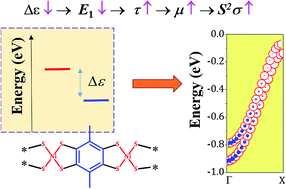Tuning the thermoelectric performance of π–d conjugated nickel coordination polymers through metal–ligand frontier molecular orbital alignment†
Abstract
π–d conjugated transition-metal coordination polymers have been rapidly emerging as one of the most attractive polymer-based thermoelectric materials in the past decade. However, the relationship between these polymers' geometric structures, orbital characteristics and their thermoelectric properties remains unclear, which has seriously hindered the development of a straightforward design strategy for π–d conjugated coordination polymer-based thermoelectric materials. Herein, taking poly(nickel-benzene-1,2,4,5-tetrathiolate) and its five derivatives as specimen models, we have studied the effect of ligand chemistry modulation on the thermoelectric properties and elucidated the structure–property relationship based on density functional calculations, and Boltzmann transport and deformation potential theories. Our theoretical results indicate that the thermoelectric power factor is governed by the frontier molecular orbital alignment between the square planar metal-tetrasulfide fragment and the organic π-conjugated spacers. Specifically, a better frontier molecular orbital alignment results in a weaker electron–phonon coupling. Consequently, higher mobility can be achieved, which leads to a higher thermoelectric power factor. This finding provides a screening rule for the rationalization and design of high performance p-type π–d conjugated transition-metal coordination thermoelectric materials.



 Please wait while we load your content...
Please wait while we load your content...